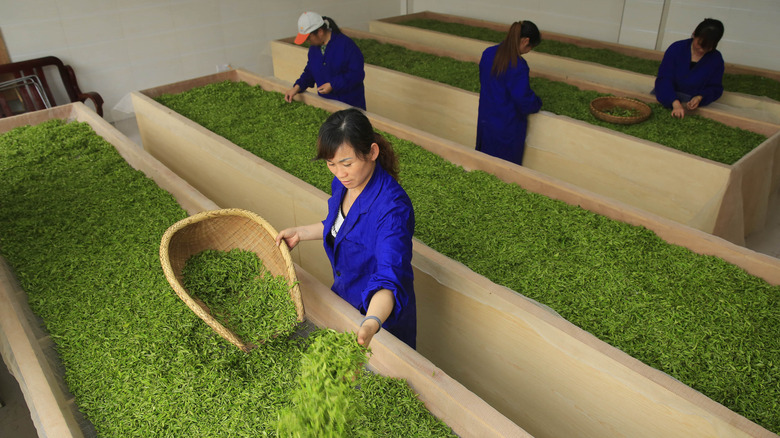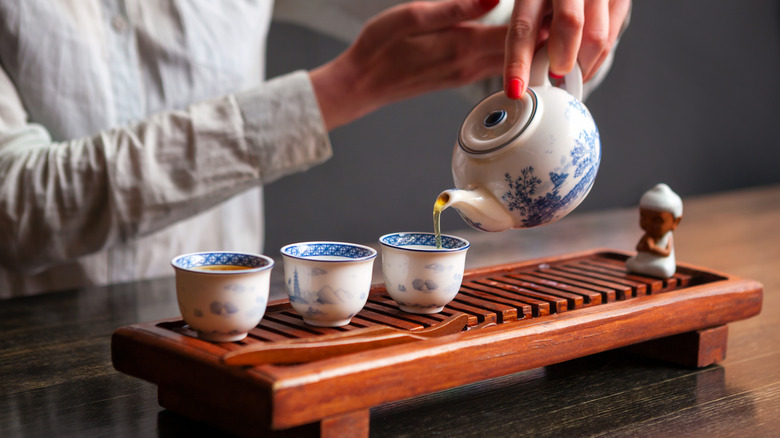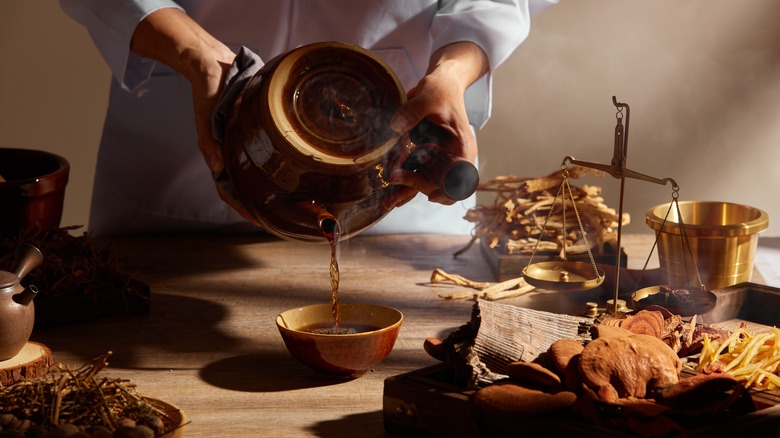Most Of The World's Tea Comes From This Country
We may receive a commission on purchases made from links.
Can you guess which commonly drunk beverage is so deeply rooted in human history and dates back as early as 2700 BC? For reference, that's about the same time the Minoans were around, one of the earliest communities in human civilization (via History Central). If you guessed tea, you are correct, according to the Food and Agriculture Organization of the United Nations (FAO). Not only has tea been around a long time, but Statista reports that it's the second-most popular drink in the world (the first, of course, is water). According to Tea USA, Americans drank around 85 billion servings of tea in 2021, and tea is present in about 80% of all American homes.
Part of the allure of tea is that there are endless varieties, and many herbal ones are thought to offer medicinal benefits. According to WebMD, rooibos is unique since it is believed to help prevent cancer, chamomile may assist with insomnia, and peppermint may soothe headaches. Tea can also be the perfect alternative for those who are too overstimulated by coffee — popular caffeinated versions include green, black, and oolong tea, which many people drink hot or iced.
According to Tea USA, America is the third-largest importer of tea in the world. But the question is, where does it all come from?
China leads the pack in tea production
You may not be surprised to learn that most of the world's tea comes from China. And it's not a close race for the top spot, either. According to the Food and Agricultural Organization of the United Nations, China won by a landslide in 2020, producing almost 3 million tons of tea leaves. India came second, only making about half as much at 1.4 million tons.
And not all Chinese tea is created equal – Statista reports that in 2021, green tea accounted for 60% of China's tea production. Here in America, we rely on Chinese exports for our green tea fix, with about half of our supply coming from China (via World Tea News). But while we may sip ours while multitasking at home or pour it in a tumbler to take on the go, ancient rituals and traditions are woven into Chinese tea-drinking culture.
Distant Journeys explains that Chinese tea ceremonies involve savoring its aroma, consuming it in three sips, and using beautiful teapots. According to Travel China Guide, Chinese varieties differ depending on their region, including Yunwu, Maofeng, Longjing, and many others.
Tea is deeply rooted in Chinese history
Not only is China the world's leading tea producer, but it's also the birthplace of tea as we know it. Legend has it that Emperor Shennong, also known as the Chinese Father of Agriculture, sat beneath a tree drinking hot water one day when dried leaves drifted from the branches above into his cup, creating tea (via China.org). However, while this allegedly took place in 2737 BC, The Spruce Eats notes that an old Chinese dictionary mentioned tea as early as 350 BC.
While the exact year tea was discovered may be difficult to pin down, it's undisputed that the Chinese cultivated the beverage from its origins. The UK Tea & Infusions Association notes that the Tang dynasty, beginning in 618 AD, was when tea secured its spot as the national drink of China. The Chinese tea ceremony, which followed soon after, can be traced to "The Classic of Tea," published in the eighth century by Buddhist Lu Yu. In this detailed guide to appreciating tea drinking, the author emphasized sipping it slowly and brewing it intentionally (via NPR).
After tea's popularity exploded in China, it made its way to Japan and then Europe and was first dubbed the "China Drink called by the Chinese, Tcha, by other Nations Tay alias Tee" when it landed in Britain in 1658, according to the UK Tea & Infusions Association.
Tea in traditional Chinese medicine
Beyond the Western health benefits we're aware of, tea and other herbal remedies play an important role in traditional Chinese medicine.
According to WebMD, traditional Chinese medicine is an ancient healthcare practice focusing on balance and well-being as a whole (this is also where yin and yang come from). So, where does tea come in? Overall, it's thought to reduce too much heat and moisture that throws off the body's natural balance (via China Admissions). Specific teas help digestion, skin inflammation, fever, cramps, and more. And according to Té Company, some teas should be drunk seasonally for optimal benefits. For example, black and oolong teas are best for the wintertime, providing ample heat and aroma to keep you warm.
Whether your mouth opts for green, black, oolong tea, or beyond, it's safe to say you're tasting one of China's oldest and most important products.



